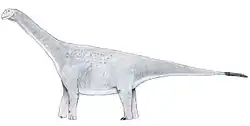| Garrigatitan Temporal range: Late Cretaceous, | |
|---|---|
| Scientific classification | |
| Domain: | Eukaryota |
| Kingdom: | Animalia |
| Phylum: | Chordata |
| Clade: | Dinosauria |
| Clade: | Saurischia |
| Clade: | †Sauropodomorpha |
| Clade: | †Sauropoda |
| Clade: | †Macronaria |
| Clade: | †Titanosauria |
| Clade: | †Lithostrotia |
| Subfamily: | †Lirainosaurinae |
| Genus: | †Garrigatitan Díaz et al., 2021 |
| Species: | †G. meridionalis |
| Binomial name | |
| †Garrigatitan meridionalis Díaz et al., 2021 | |
Garrigatitan (meaning "garrigue giant") is a genus of titanosaurian dinosaur from the late Cretaceous Period of the Grès à Reptiles Formation in France. The genus contains a single species, Garrigatitan meridionalis.[1]
Discovery and naming
Between 2009 and 2012, excavations were carried out at Velaux-La Bastide Neuve by the Palaios Association and the University of Poitiers. During the excavations, the holotype of Garrigatitan was discovered along with the remains of Atsinganosaurus, another titanosaurian.[2]
In 2021, the type species Garrigatitan meridionalis was named and described by Verónica Díez Díaz, Géraldine Garcia, Xabier Pereda Suberbiola, Benjamin Jentgen-Ceschino, Koen Stein, Pascal Godefroit and Xavier Valentin. The holotype, MMS / VBN.09.17, was found in a layer of sandstone of the Begudian, the second level of the second series, dating back to the late Campanian. It consists of a sacrum belonging to an immature individual.[1]
Additional fossil material has been assigned to the species including a cervical vertebra, two humeri, a left ilium, and a right ischial bone. Other specimens recovered include a neural spine, a right humerus, part of the right leg, and a left femur. The assigned specimens come from the third level of the second series. The fossils were found within an area of 375 square meters and a thickness of 1.2 metres (3.9 ft). They were not associated and presumably represent different individuals. They are all part of the Moulin Seigneurial de Velaux collection.[1]
The generic name, "Garrigatitan," is a combination of the Occitan "garriga," meaning "dry thicket", referring to a type of Mediterranean vegetation characterized by drought-resistant shrubs, and the Greek "titan", after the Greek mythological family of giants. The specific epithet, "meridonalis," means "southern" in Latin, in reference to the discovery location in southern France.[1]
Description
Some Garrigatitan specimens regarded as subadults or adults belonged to individuals measuring 4–6 metres (13–20 ft) long and weighing 2–2.5 metric tons (2.2–2.8 short tons). A tentatively referred specimen belonged to an adult individual measuring about 12–16 metres (39–52 ft) long.[1]
Classification
Cladistic analysis of Garrigatitan shows that it belonged to the subfamily Lirainosaurinae.[1]
| Lirainosaurinae |
| ||||||||||||||||||
References
- 1 2 3 4 5 6 Díez Díaz, Verónica; Garcia, Géraldine; Pereda Suberbiola, Xabier; Jentgen-Ceschino, Benjamin; Stein, Koen; Godefroit, Pascal; Valentin, Xavier (2021). "A new titanosaur (Dinosauria: Sauropoda) from the Upper Cretaceous of Velaux-La-Bastide Neuve (southern France)". Historical Biology. 33 (11): 2998–3017. doi:10.1080/08912963.2020.1841184. ISSN 0891-2963. S2CID 234404741.
- ↑ B. Vila; A. Galobart; J.U. Canudo; J. Le Loeff; et al. (2012). "The diversity of sauropod dinosaurs and their first taxonomic succession from the latest Cretaceous of southwestern Europe: Clues to demise and extinction". Palaeogeography, Palaeoclimatology, Palaeoecology. 350–352 (15): 19–38. Bibcode:2012PPP...350...19V. doi:10.1016/j.palaeo.2012.06.008.










